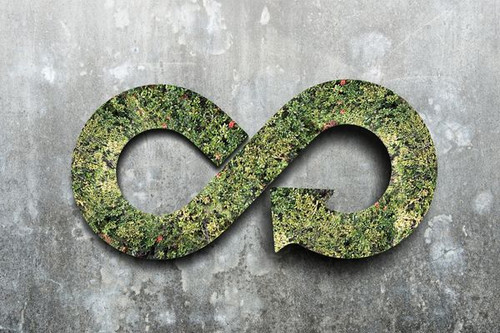The Case Against Degradable Plastic Packaging
Posted By on Aug 30th 2022
Over the past few months, we've received dozens of questions about and requests for degradable packaging.
There is no specific definition for "degradable plastic." Typically, this term refers to a traditional petroleum-based plastic treated with additives that will enhance the material's ability to degrade or biodegrade in different environments.
We can certainly understand the appeal of this! The idea that manufacturers can design a single-use plastic package to "disappear" after dozens of years instead of thousands of years seems like an exciting solution.
As a packaging innovator working with various materials and constructions, EcoEnclose is uniquely positioned in the packaging industry. Our primary commitment is to sustainable packaging, not to a specific technology, piece of equipment, or type of material. Because of this, if innovations or trends align with our sustainability vision and framework, we work to incorporate them into our packaging solutions - it's that simple.
With that lens, we dug into the science, research, and perspectives on the increasingly crowded landscape of plastic additives for degradability.
Should EcoEnclose actively incorporate additives that enhance plastic biodegradability into our offerings?
Based on what we learned, we have decided that for now - we are NOT pursuing additives that enhance the degradation of eCommerce packaging. Currently, these additives are not ecologically advantageous and, in some cases, can be a step backward as we work towards circularity.
We will continue to research this space and dialogue with innovators, most of whom are genuinely committed to a cleaner and more sustainable future.
That said, we believe that for a plastic additive to be a step forward for the environment, it must: rapidly enhances actual biodegradability in a marine environment, keep plastic stable within a landfill environment, not hinder recyclability of the material, be easily added to post-consumer resin, and not aim to push brands and consumers to encourage composting as the end of life solution of petroleum-based plastics.

We see the primary potential benefit of plastic additives as protecting the planet when plastic leaks out of appropriate waste streams (recycling and landfilling). With that in mind, we encourage those developing the most promising additives (those that lead to relatively rapid biodegradation in the ocean) to primarily focus on applying their technology to packaging with the highest potential for leakage. This packaging refers to the most common ocean plastic pollution offenders, such as candy bar wrappers, snack packaging, soda caps, takeaway food packaging, disposable cutlery, plastic straws, etc.
Read on for an overview of our research findings and rationale on plastic additives and why - as of today - this technology does not meet our Sustainability Vision and Sustainable Packaging Framework.
For a far more in-depth overview of additives and the broader bioplastics landscape, check out our Resource Hub for Bioplastics and our Whitepaper on Bioplastics and Dissolvable Plastics for eCommerce Packaging.
An Overview of Degradable Plastic Terms
One trend in this space is that the companies behind the development and commercialization of plastic additives tend to create new terms to define their products. Each word is slightly different based on how its additive is produced and its specific impact on degradation. Here we share a small sampling of the terms we've read about and researched.
Degradable: This blanket term means an item can break down biologically or chemically. It is essential to recognize that every product and material is technically degradable. For example, standard untreated plastic is already degradable. However, when the term is typically used in packaging, it is intended to mean the plastic was treated with an additive that aims to make it degrade in at least one environment (i.e., land, ocean, compost, or landfill) more rapidly than it otherwise would.
Omni-Degradable™: A term developed by TekPak that they define as "a particular blend of Organic compounds, which in the presence of microbes, create an enzyme that breaks down the long-chain molecules of the plastic. This allows the microbes to then consume the plastic."
Bio-Assimilation: A term developed by Smart Plastic that they define as "plastic that has reduced to a molecular weight that can be consumed by microorganisms."
Oxo-Degradable: A technology and term introduced over a decade ago in which plastics quickly fragment into smaller and smaller pieces, called microplastics, but don't break down at the molecular or polymer level. This technology is - thankfully - widely recognized today to be terrible for the planet! As a result, the new wave of additives hitting the market today are (rightfully) quick to distance themselves from oxo-biodegradability.

Why We Are Currently Avoiding Additives for Plastic Degradation
Biodegradation in landfills is not good for the planet.
Over 80% of plastic ends up in landfills. We (manufacturers, brands, and consumers) must work to change this to build a more circular future. However, this is our current reality.
Most degradability-enhancing additives are designed to accelerate biodegradation in a landfill (i.e., an anaerobic environment). This sounds good in theory because many people are incorrectly taught that the biggest waste management challenge is "space in landfills" and that we need things to "go away" in landfills to create more space. This thought process is incorrect.
One of the most critical challenges related to waste management today is landfill gas emissions and - in particular - the methane that is created and released into the atmosphere when garbage degrades in an anaerobic environment. Research has shown that landfill gas is the third largest contributor to methane emissions in the US. Methane has an atmospheric lifetime of about 12 years and a global warming potential of about 25 over 100 years, meaning a pound of methane has 25 times the warming power of a pound of carbon dioxide over this timespan. So, finding ways to reduce (rather than actively increase) methane emissions is critical.
The idea of adding properties to plastic to encourage biodegradation in a landfill runs counter to what we need to reduce emissions. Proponents of plastic additives for landfill biodegradation argue that if landfills convert methane into power, the additives turn the plastic into a "regenerative" energy source. First, it is essential to note that of the 2,600 municipal solid waste landfills tracked by the EPA, only about 500 collect methane for energy production. Additionally, research has shown that even landfills that convert methane emissions into energy still leak these potent greenhouse gases into the atmosphere.
For the time being, we want anything that ends up in the landfill to remain as stable as possible in anaerobic conditions.
In most cases, these additives are applied to virgin petroleum-based plastics, a step that hinders innovation concerning recycled resin and regenerative bioplastic resin.
Many additives are marketed in such a way that they are aimed at making virgin, petroleum-based plastics "look good" from a marketing perspective.
EcoEnclose fully recognizes that virgin, petroleum-based plastics play an essential role in our world today, from packaging to medicine to manufacturing. However, we also acknowledge that virgin, petroleum-based plastics are not ideal and should not be our future.
Virgin plastics are significantly more carbon-emitting, polluting, and water-consuming than recycled plastics. Our vision for the future is one in which the vast majority of packaging is made from packaging (i.e., from recycled content), and any new virgin plastic is made from regenerative source materials (such as hemp, kelp, and food waste). We believe these additives have the terrible impact of making brands comfortable with and excited about virgin petroleum-based plastic. This perspective will stall the innovation we all need to pursue to achieve a more circular future.
These additives are often "tested" for compostability and marine biodegradation standards without meeting critical thresholds.
Many of these additives have undergone third-party testing, such as ASTM5511, which tests for biodegradation in an anaerobic environment like a landfill, and ASTM D5338, which tests for aerobic biodegradation of plastic materials under controlled composting conditions. When reviewing the research, we'll find that an additive will enhance biodegradation, but only to a point.
Additionally, we've seen a lot of testing that shows plastics with additives may degrade or biodegrade to 60% or 30% of their weight within a few years. While this is better than 0%, we also recognize that (1) it doesn't fully biodegrade in a brief period, and (2) the environmental community is aware that controlled testing environments are rarely replicated in the real world. We love that companies developing these additives are rigorous in their testing. However, we would also love to see them more openly share the data in ways that brands and consumers can understand.

Plastic with enhancing additives would add no nutrient value to composting operations even if they render a plastic technically compostable.
We've noticed that some companies designing these additives are promoting their technology as one that can make petroleum-based plastics compostable. Even if an additive makes a petro plastic compostable (which most have not achieved because they do not biodegrade in short enough time), compost is not enriched or enhanced when bioplastic is added. Packaging should only be designed for compostability if it serves as a vehicle to bring food or yard waste into this waste stream (helping to divert this organic waste from the landfill where it will create methane). As compost has opened up to more and more businesses and households, industrial composting is often degrading in quality and becoming contaminated, contamination that then ends up on farms, public lands, and landscaping - mainly due to the influx of both compostable and non-compostable packaging.
Additives could encourage even more carelessness regarding plastic disposal and waste management.
If a consumer reads a package that shouts, " I will biodegrade in the landfill, or I will biodegrade in the ocean." It inevitably will lead to lower recycling rates and perhaps more cavalier behavior when it comes to litter. The environmental community agrees that the best end-of-life outcome for nonfood packaging is for it to be recycled, and technologies and marketing that hinder this progress should be reviewed and messaged very carefully.
Thus far, the biodegradability enhancing additives we have encountered:
- Don't support our long-term future of circularity and regeneration.
- Actively create methane emissions.
- Don't solve the leakage problem of what happens when plastic leaks out of the landfill or recycling system and ends up in the ocean.
Key Takeaways
1. Misleading Labels
Terms like "degradable" and "oxo-degradable" can be deceptive, often implying environmental benefits that aren't realized in practice.
2. Incomplete Decomposition
Degradable plastics typically fragment into microplastics rather than fully breaking down, contributing to long-term pollution.
3. Recycling Contamination
These plastics can contaminate recycling streams, as they aren't compatible with standard recycling processes.
4. Lack of Compostability
Degradable plastics don't meet compostability standards and won't decompose effectively in home or industrial composting systems.
5. Prefer Recycled Content
Opting for packaging made from recycled materials is a more sustainable choice, reducing reliance on virgin plastics and minimizing environmental impact.
About EcoEnclose
EcoEnclose is the leading sustainable packaging company that provides eco-packaging solutions to the world’s most forward-thinking brands.
We develop diverse, sustainable packaging solutions that meet our rigorous research-based standards and customers’ goals. We drive innovative packaging materials to market and consistently improve the circularity of existing solutions.



